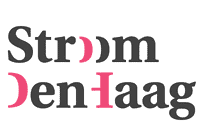Sigurdur Gudmundsson, 1996, 'Zonder titel', brons foto: Renate Boere, Cas Marks, Laurens van der Pool
Sigurdur Gudmundsson, (no title), 1996
Location: Center of The Hague: Spui - Grote Marktstraat - Kalvermarkt
Kneeling on the sidewalk with his head under a paving stone, buried under a pile of books or hanging from a burning beam: with these black-and-white photographs, Icelandic-born artist Sigurdur Gudmundsson (b. 1942) conquered the Dutch art world in the 1970s. The photographs show the artist in all sorts of absurd poses and incongruous situations. They are based on strange trains of thought and curious staging.
Ten years later, Gudmundsson no longer expresses himself in absurd, staged photographs. In sculpture, he then finds a more appropriate medium. As in painting, a major change is taking place within sculpture at that time. After years of sculpture being dominated by abstraction and minimalism, in the early 1980s there was room for figuration, the narrative and the tactile. The high-profile exhibition “The Great Poem” in The Hague's Grote Kerk (1994) marked that transition from abstract, minimal sculpture to extremely free sculpture. The title of the exhibition is taken from a sculpture of the same name that Gudmundsson completed in 1981.
In his work, the Icelandic artist, who settled permanently in the Netherlands in 1970, unites his romantic vision of rugged nature, poetry and beauty with solid sculpture and a partly conceptual approach. The materials chosen are heavy, basalt, concrete, bronze with lighter touches such as feathers or glass. The forms, a tower, a house, a boat, in which Gudmundsson presents these materials, he derives from the archetypal world of sculpture recognizable to all.He strives for sculptures that possess a poetic and personal aura on the one hand, but are also timeless and universal on the other.
For the Pedestal Project, Gudmundsson designed a head. Usually, with this sculptor, that would have resulted in a one-piece sculpture.However, his pedestal sculpture is transparent because it is composed of bronze branches. Another archetype.

